Reflection Report: Practice Education and Mentorship Assignment - MSc
VerifiedAdded on 2023/01/17
|16
|4716
|86
Report
AI Summary
This report is a comprehensive reflection on the Practice Education and Mentorship module within an MSc in Medical Imaging program. The student critically analyzes their understanding of professional competence as a Practice Educator, focusing on how the course has enhanced their knowledge of teaching and learning strategies. The report delves into various aspects, including recognizing learning styles, providing learning opportunities, graded exposure, and promoting autonomous problem-solving and reflection. The student also examines the importance of feedback and how practice placement experiences influence the recruitment and retention of therapeutic radiographers. The report includes a structured essay with sections on teaching strategies, the influence of practice placements on recruitment and retention, and a journal article synopsis. The student outlines plans to revise their approach to effectively support, educate, and mentor learners, with a focus on continuous improvement and adaptation to meet student needs. The report emphasizes the practical application of theoretical concepts, aiming to bridge the gap between theory and practice.
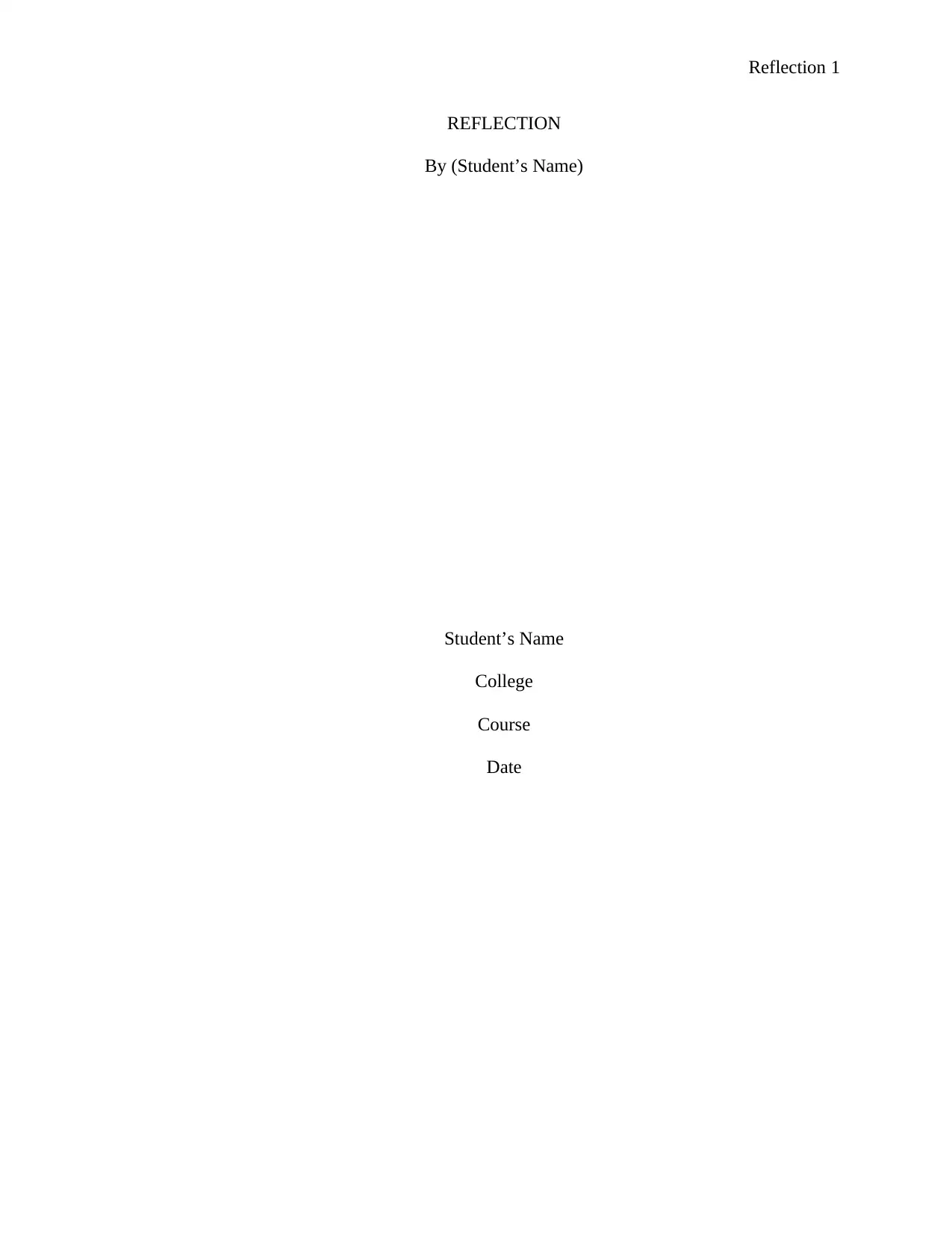
Reflection 1
REFLECTION
By (Student’s Name)
Student’s Name
College
Course
Date
REFLECTION
By (Student’s Name)
Student’s Name
College
Course
Date
Paraphrase This Document
Need a fresh take? Get an instant paraphrase of this document with our AI Paraphraser
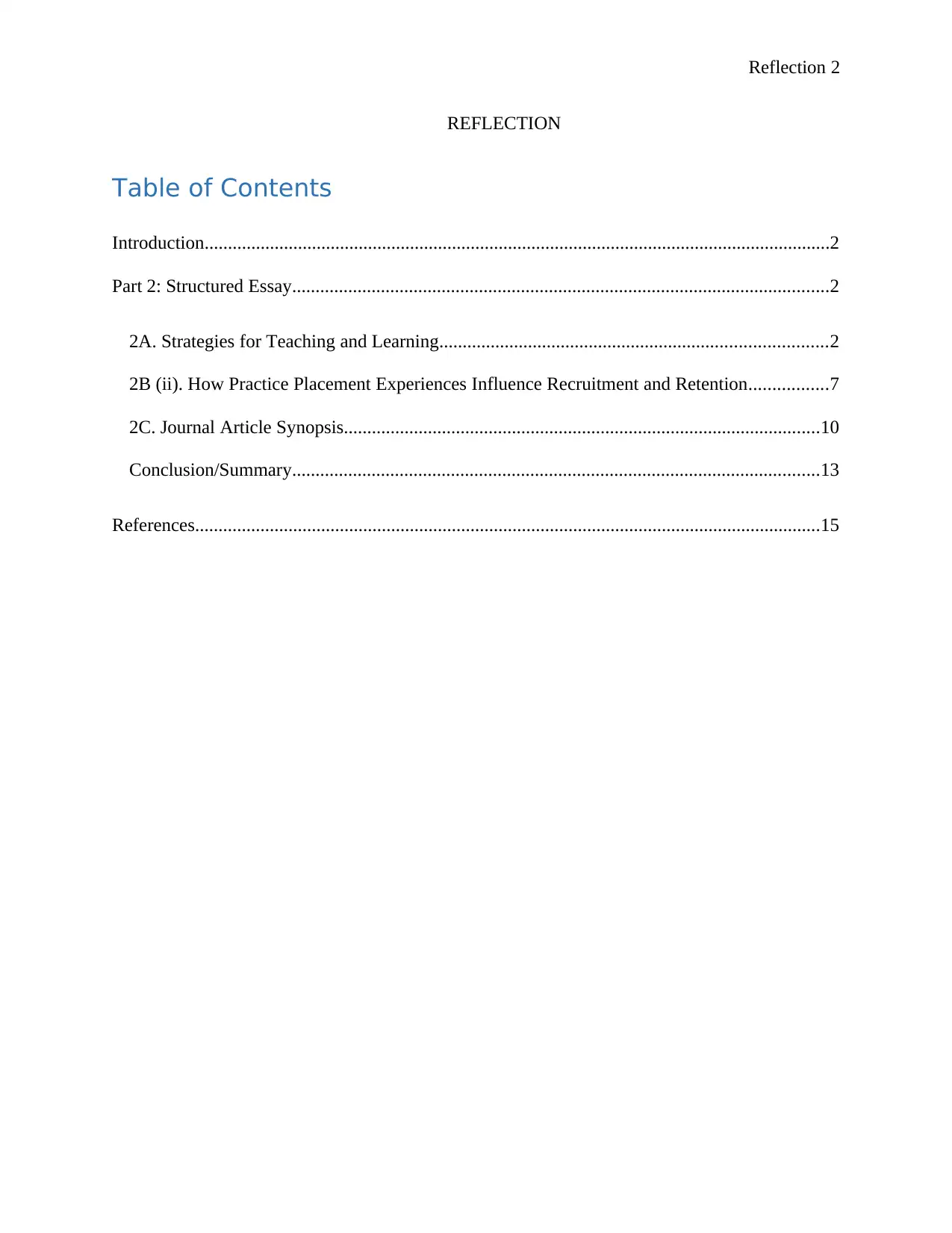
Reflection 2
REFLECTION
Table of Contents
Introduction......................................................................................................................................2
Part 2: Structured Essay...................................................................................................................2
2A. Strategies for Teaching and Learning...................................................................................2
2B (ii). How Practice Placement Experiences Influence Recruitment and Retention.................7
2C. Journal Article Synopsis......................................................................................................10
Conclusion/Summary.................................................................................................................13
References......................................................................................................................................15
REFLECTION
Table of Contents
Introduction......................................................................................................................................2
Part 2: Structured Essay...................................................................................................................2
2A. Strategies for Teaching and Learning...................................................................................2
2B (ii). How Practice Placement Experiences Influence Recruitment and Retention.................7
2C. Journal Article Synopsis......................................................................................................10
Conclusion/Summary.................................................................................................................13
References......................................................................................................................................15
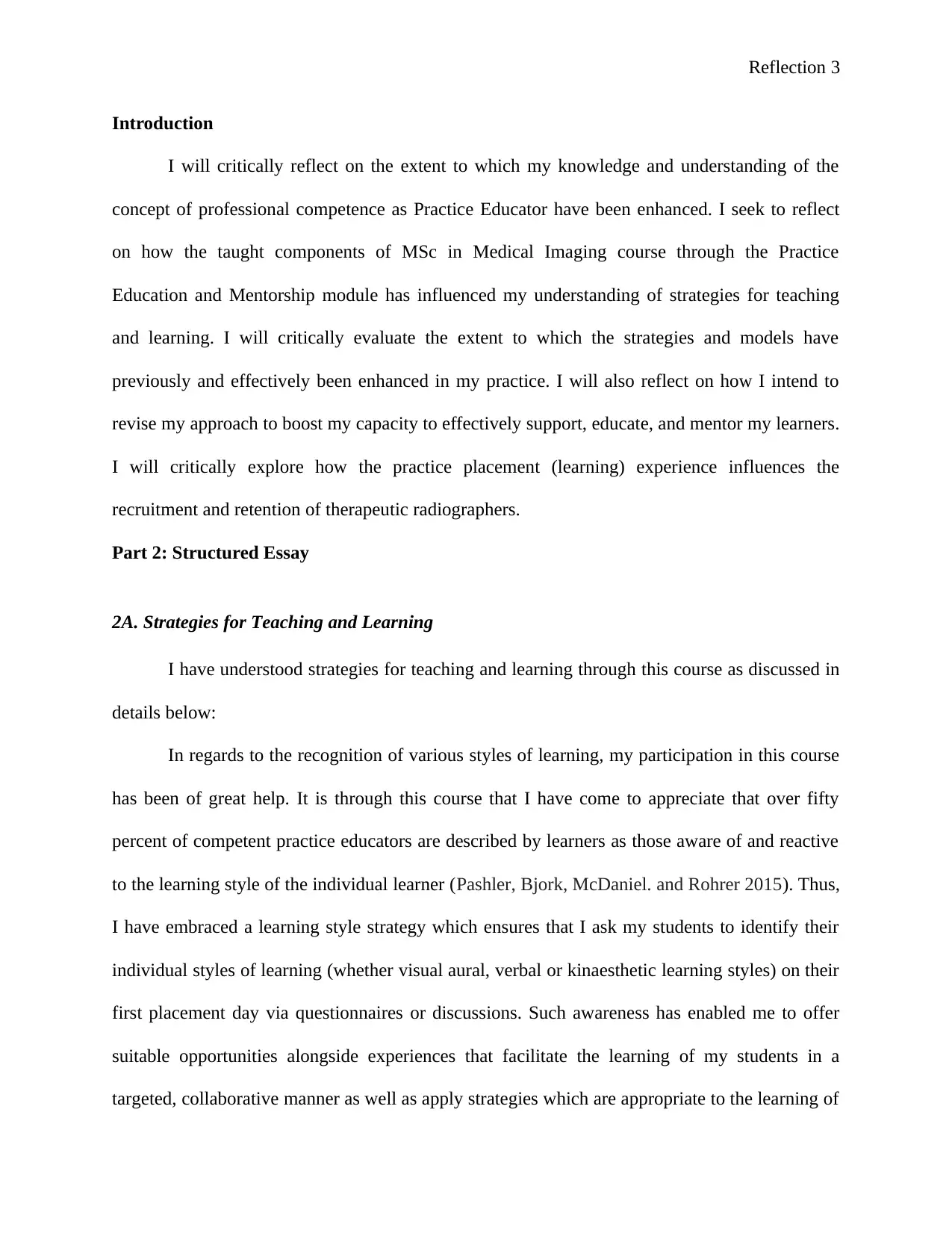
Reflection 3
Introduction
I will critically reflect on the extent to which my knowledge and understanding of the
concept of professional competence as Practice Educator have been enhanced. I seek to reflect
on how the taught components of MSc in Medical Imaging course through the Practice
Education and Mentorship module has influenced my understanding of strategies for teaching
and learning. I will critically evaluate the extent to which the strategies and models have
previously and effectively been enhanced in my practice. I will also reflect on how I intend to
revise my approach to boost my capacity to effectively support, educate, and mentor my learners.
I will critically explore how the practice placement (learning) experience influences the
recruitment and retention of therapeutic radiographers.
Part 2: Structured Essay
2A. Strategies for Teaching and Learning
I have understood strategies for teaching and learning through this course as discussed in
details below:
In regards to the recognition of various styles of learning, my participation in this course
has been of great help. It is through this course that I have come to appreciate that over fifty
percent of competent practice educators are described by learners as those aware of and reactive
to the learning style of the individual learner (Pashler, Bjork, McDaniel. and Rohrer 2015). Thus,
I have embraced a learning style strategy which ensures that I ask my students to identify their
individual styles of learning (whether visual aural, verbal or kinaesthetic learning styles) on their
first placement day via questionnaires or discussions. Such awareness has enabled me to offer
suitable opportunities alongside experiences that facilitate the learning of my students in a
targeted, collaborative manner as well as apply strategies which are appropriate to the learning of
Introduction
I will critically reflect on the extent to which my knowledge and understanding of the
concept of professional competence as Practice Educator have been enhanced. I seek to reflect
on how the taught components of MSc in Medical Imaging course through the Practice
Education and Mentorship module has influenced my understanding of strategies for teaching
and learning. I will critically evaluate the extent to which the strategies and models have
previously and effectively been enhanced in my practice. I will also reflect on how I intend to
revise my approach to boost my capacity to effectively support, educate, and mentor my learners.
I will critically explore how the practice placement (learning) experience influences the
recruitment and retention of therapeutic radiographers.
Part 2: Structured Essay
2A. Strategies for Teaching and Learning
I have understood strategies for teaching and learning through this course as discussed in
details below:
In regards to the recognition of various styles of learning, my participation in this course
has been of great help. It is through this course that I have come to appreciate that over fifty
percent of competent practice educators are described by learners as those aware of and reactive
to the learning style of the individual learner (Pashler, Bjork, McDaniel. and Rohrer 2015). Thus,
I have embraced a learning style strategy which ensures that I ask my students to identify their
individual styles of learning (whether visual aural, verbal or kinaesthetic learning styles) on their
first placement day via questionnaires or discussions. Such awareness has enabled me to offer
suitable opportunities alongside experiences that facilitate the learning of my students in a
targeted, collaborative manner as well as apply strategies which are appropriate to the learning of
⊘ This is a preview!⊘
Do you want full access?
Subscribe today to unlock all pages.

Trusted by 1+ million students worldwide
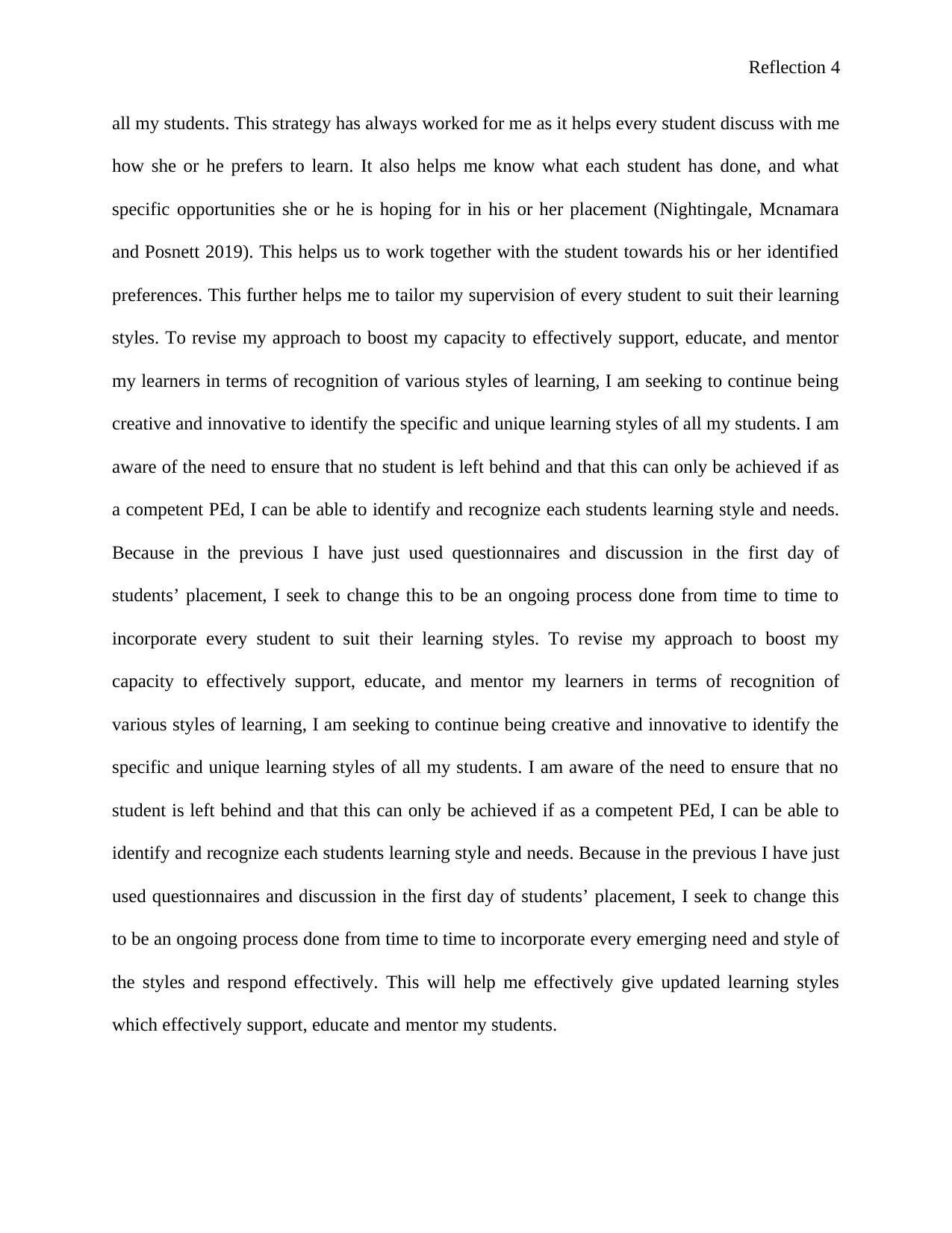
Reflection 4
all my students. This strategy has always worked for me as it helps every student discuss with me
how she or he prefers to learn. It also helps me know what each student has done, and what
specific opportunities she or he is hoping for in his or her placement (Nightingale, Mcnamara
and Posnett 2019). This helps us to work together with the student towards his or her identified
preferences. This further helps me to tailor my supervision of every student to suit their learning
styles. To revise my approach to boost my capacity to effectively support, educate, and mentor
my learners in terms of recognition of various styles of learning, I am seeking to continue being
creative and innovative to identify the specific and unique learning styles of all my students. I am
aware of the need to ensure that no student is left behind and that this can only be achieved if as
a competent PEd, I can be able to identify and recognize each students learning style and needs.
Because in the previous I have just used questionnaires and discussion in the first day of
students’ placement, I seek to change this to be an ongoing process done from time to time to
incorporate every student to suit their learning styles. To revise my approach to boost my
capacity to effectively support, educate, and mentor my learners in terms of recognition of
various styles of learning, I am seeking to continue being creative and innovative to identify the
specific and unique learning styles of all my students. I am aware of the need to ensure that no
student is left behind and that this can only be achieved if as a competent PEd, I can be able to
identify and recognize each students learning style and needs. Because in the previous I have just
used questionnaires and discussion in the first day of students’ placement, I seek to change this
to be an ongoing process done from time to time to incorporate every emerging need and style of
the styles and respond effectively. This will help me effectively give updated learning styles
which effectively support, educate and mentor my students.
all my students. This strategy has always worked for me as it helps every student discuss with me
how she or he prefers to learn. It also helps me know what each student has done, and what
specific opportunities she or he is hoping for in his or her placement (Nightingale, Mcnamara
and Posnett 2019). This helps us to work together with the student towards his or her identified
preferences. This further helps me to tailor my supervision of every student to suit their learning
styles. To revise my approach to boost my capacity to effectively support, educate, and mentor
my learners in terms of recognition of various styles of learning, I am seeking to continue being
creative and innovative to identify the specific and unique learning styles of all my students. I am
aware of the need to ensure that no student is left behind and that this can only be achieved if as
a competent PEd, I can be able to identify and recognize each students learning style and needs.
Because in the previous I have just used questionnaires and discussion in the first day of
students’ placement, I seek to change this to be an ongoing process done from time to time to
incorporate every student to suit their learning styles. To revise my approach to boost my
capacity to effectively support, educate, and mentor my learners in terms of recognition of
various styles of learning, I am seeking to continue being creative and innovative to identify the
specific and unique learning styles of all my students. I am aware of the need to ensure that no
student is left behind and that this can only be achieved if as a competent PEd, I can be able to
identify and recognize each students learning style and needs. Because in the previous I have just
used questionnaires and discussion in the first day of students’ placement, I seek to change this
to be an ongoing process done from time to time to incorporate every emerging need and style of
the styles and respond effectively. This will help me effectively give updated learning styles
which effectively support, educate and mentor my students.
Paraphrase This Document
Need a fresh take? Get an instant paraphrase of this document with our AI Paraphraser
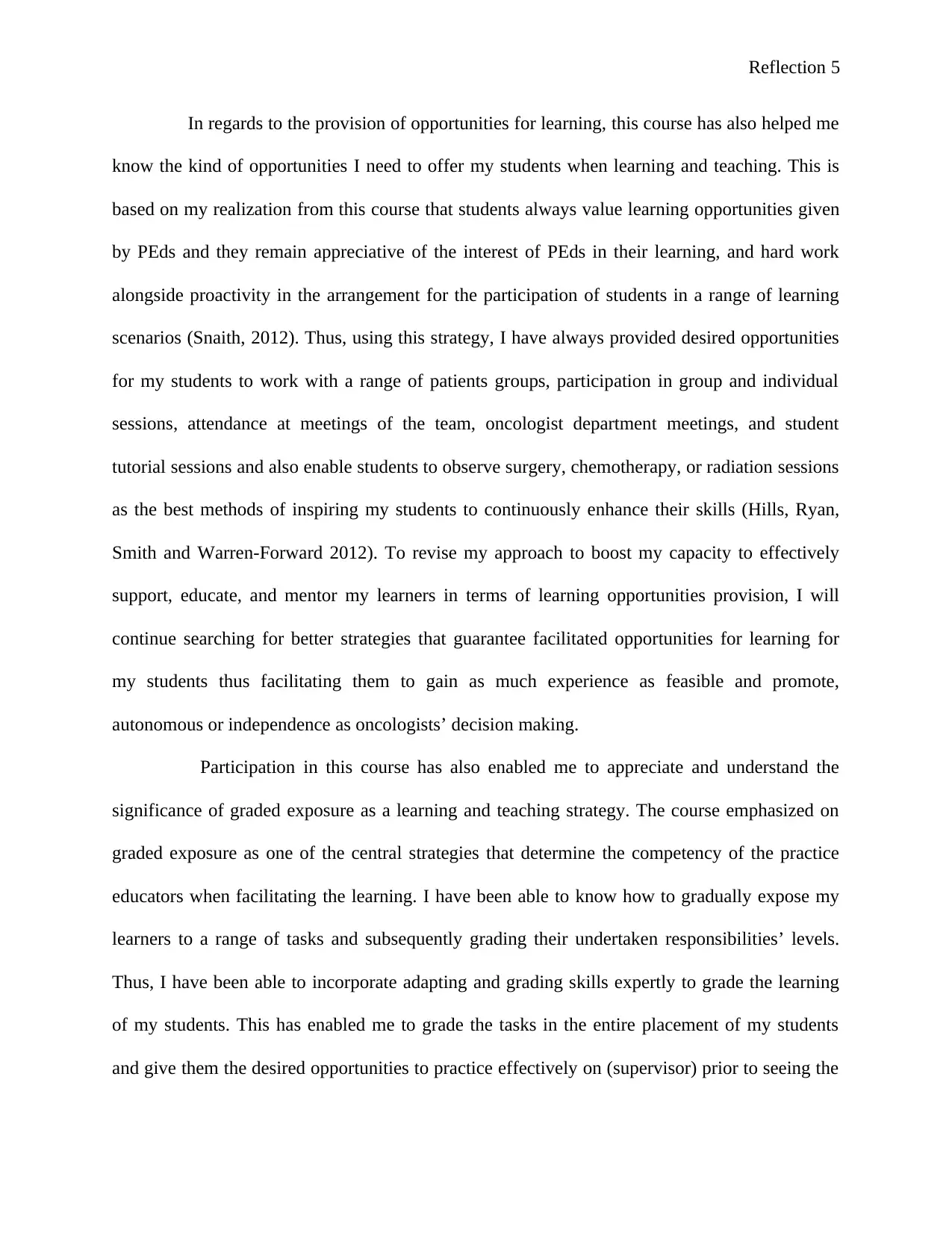
Reflection 5
In regards to the provision of opportunities for learning, this course has also helped me
know the kind of opportunities I need to offer my students when learning and teaching. This is
based on my realization from this course that students always value learning opportunities given
by PEds and they remain appreciative of the interest of PEds in their learning, and hard work
alongside proactivity in the arrangement for the participation of students in a range of learning
scenarios (Snaith, 2012). Thus, using this strategy, I have always provided desired opportunities
for my students to work with a range of patients groups, participation in group and individual
sessions, attendance at meetings of the team, oncologist department meetings, and student
tutorial sessions and also enable students to observe surgery, chemotherapy, or radiation sessions
as the best methods of inspiring my students to continuously enhance their skills (Hills, Ryan,
Smith and Warren-Forward 2012). To revise my approach to boost my capacity to effectively
support, educate, and mentor my learners in terms of learning opportunities provision, I will
continue searching for better strategies that guarantee facilitated opportunities for learning for
my students thus facilitating them to gain as much experience as feasible and promote,
autonomous or independence as oncologists’ decision making.
Participation in this course has also enabled me to appreciate and understand the
significance of graded exposure as a learning and teaching strategy. The course emphasized on
graded exposure as one of the central strategies that determine the competency of the practice
educators when facilitating the learning. I have been able to know how to gradually expose my
learners to a range of tasks and subsequently grading their undertaken responsibilities’ levels.
Thus, I have been able to incorporate adapting and grading skills expertly to grade the learning
of my students. This has enabled me to grade the tasks in the entire placement of my students
and give them the desired opportunities to practice effectively on (supervisor) prior to seeing the
In regards to the provision of opportunities for learning, this course has also helped me
know the kind of opportunities I need to offer my students when learning and teaching. This is
based on my realization from this course that students always value learning opportunities given
by PEds and they remain appreciative of the interest of PEds in their learning, and hard work
alongside proactivity in the arrangement for the participation of students in a range of learning
scenarios (Snaith, 2012). Thus, using this strategy, I have always provided desired opportunities
for my students to work with a range of patients groups, participation in group and individual
sessions, attendance at meetings of the team, oncologist department meetings, and student
tutorial sessions and also enable students to observe surgery, chemotherapy, or radiation sessions
as the best methods of inspiring my students to continuously enhance their skills (Hills, Ryan,
Smith and Warren-Forward 2012). To revise my approach to boost my capacity to effectively
support, educate, and mentor my learners in terms of learning opportunities provision, I will
continue searching for better strategies that guarantee facilitated opportunities for learning for
my students thus facilitating them to gain as much experience as feasible and promote,
autonomous or independence as oncologists’ decision making.
Participation in this course has also enabled me to appreciate and understand the
significance of graded exposure as a learning and teaching strategy. The course emphasized on
graded exposure as one of the central strategies that determine the competency of the practice
educators when facilitating the learning. I have been able to know how to gradually expose my
learners to a range of tasks and subsequently grading their undertaken responsibilities’ levels.
Thus, I have been able to incorporate adapting and grading skills expertly to grade the learning
of my students. This has enabled me to grade the tasks in the entire placement of my students
and give them the desired opportunities to practice effectively on (supervisor) prior to seeing the
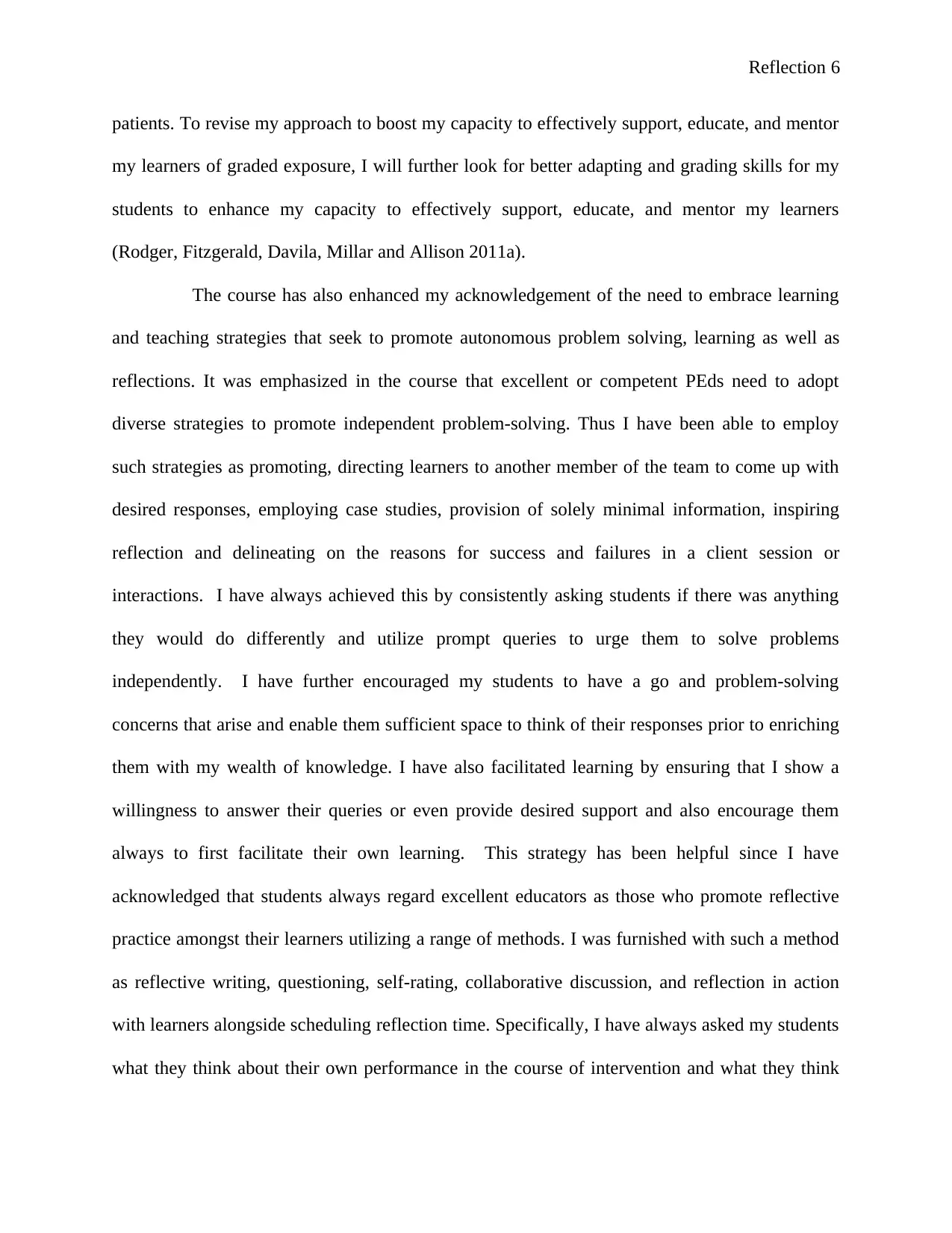
Reflection 6
patients. To revise my approach to boost my capacity to effectively support, educate, and mentor
my learners of graded exposure, I will further look for better adapting and grading skills for my
students to enhance my capacity to effectively support, educate, and mentor my learners
(Rodger, Fitzgerald, Davila, Millar and Allison 2011a).
The course has also enhanced my acknowledgement of the need to embrace learning
and teaching strategies that seek to promote autonomous problem solving, learning as well as
reflections. It was emphasized in the course that excellent or competent PEds need to adopt
diverse strategies to promote independent problem-solving. Thus I have been able to employ
such strategies as promoting, directing learners to another member of the team to come up with
desired responses, employing case studies, provision of solely minimal information, inspiring
reflection and delineating on the reasons for success and failures in a client session or
interactions. I have always achieved this by consistently asking students if there was anything
they would do differently and utilize prompt queries to urge them to solve problems
independently. I have further encouraged my students to have a go and problem-solving
concerns that arise and enable them sufficient space to think of their responses prior to enriching
them with my wealth of knowledge. I have also facilitated learning by ensuring that I show a
willingness to answer their queries or even provide desired support and also encourage them
always to first facilitate their own learning. This strategy has been helpful since I have
acknowledged that students always regard excellent educators as those who promote reflective
practice amongst their learners utilizing a range of methods. I was furnished with such a method
as reflective writing, questioning, self-rating, collaborative discussion, and reflection in action
with learners alongside scheduling reflection time. Specifically, I have always asked my students
what they think about their own performance in the course of intervention and what they think
patients. To revise my approach to boost my capacity to effectively support, educate, and mentor
my learners of graded exposure, I will further look for better adapting and grading skills for my
students to enhance my capacity to effectively support, educate, and mentor my learners
(Rodger, Fitzgerald, Davila, Millar and Allison 2011a).
The course has also enhanced my acknowledgement of the need to embrace learning
and teaching strategies that seek to promote autonomous problem solving, learning as well as
reflections. It was emphasized in the course that excellent or competent PEds need to adopt
diverse strategies to promote independent problem-solving. Thus I have been able to employ
such strategies as promoting, directing learners to another member of the team to come up with
desired responses, employing case studies, provision of solely minimal information, inspiring
reflection and delineating on the reasons for success and failures in a client session or
interactions. I have always achieved this by consistently asking students if there was anything
they would do differently and utilize prompt queries to urge them to solve problems
independently. I have further encouraged my students to have a go and problem-solving
concerns that arise and enable them sufficient space to think of their responses prior to enriching
them with my wealth of knowledge. I have also facilitated learning by ensuring that I show a
willingness to answer their queries or even provide desired support and also encourage them
always to first facilitate their own learning. This strategy has been helpful since I have
acknowledged that students always regard excellent educators as those who promote reflective
practice amongst their learners utilizing a range of methods. I was furnished with such a method
as reflective writing, questioning, self-rating, collaborative discussion, and reflection in action
with learners alongside scheduling reflection time. Specifically, I have always asked my students
what they think about their own performance in the course of intervention and what they think
⊘ This is a preview!⊘
Do you want full access?
Subscribe today to unlock all pages.

Trusted by 1+ million students worldwide
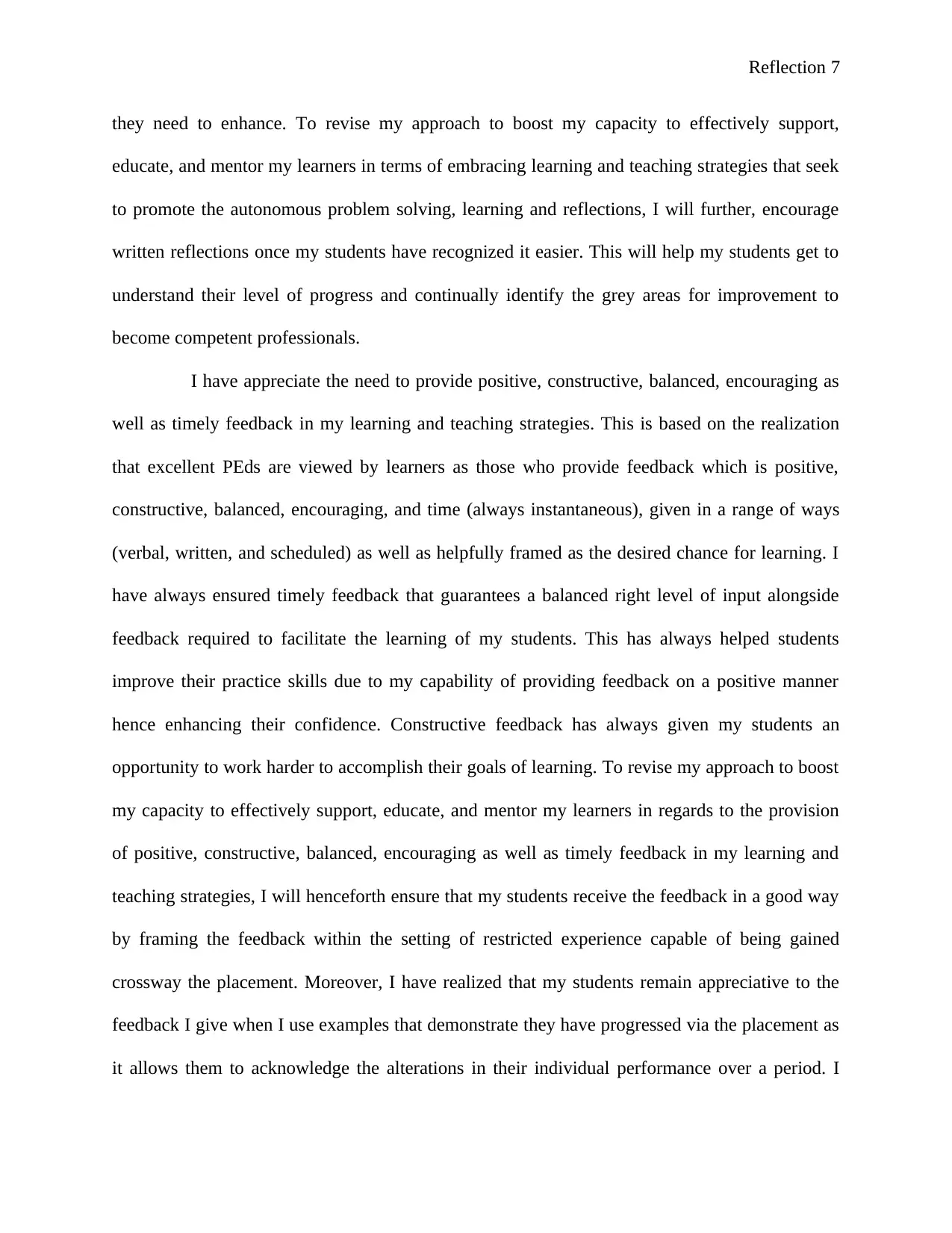
Reflection 7
they need to enhance. To revise my approach to boost my capacity to effectively support,
educate, and mentor my learners in terms of embracing learning and teaching strategies that seek
to promote the autonomous problem solving, learning and reflections, I will further, encourage
written reflections once my students have recognized it easier. This will help my students get to
understand their level of progress and continually identify the grey areas for improvement to
become competent professionals.
I have appreciate the need to provide positive, constructive, balanced, encouraging as
well as timely feedback in my learning and teaching strategies. This is based on the realization
that excellent PEds are viewed by learners as those who provide feedback which is positive,
constructive, balanced, encouraging, and time (always instantaneous), given in a range of ways
(verbal, written, and scheduled) as well as helpfully framed as the desired chance for learning. I
have always ensured timely feedback that guarantees a balanced right level of input alongside
feedback required to facilitate the learning of my students. This has always helped students
improve their practice skills due to my capability of providing feedback on a positive manner
hence enhancing their confidence. Constructive feedback has always given my students an
opportunity to work harder to accomplish their goals of learning. To revise my approach to boost
my capacity to effectively support, educate, and mentor my learners in regards to the provision
of positive, constructive, balanced, encouraging as well as timely feedback in my learning and
teaching strategies, I will henceforth ensure that my students receive the feedback in a good way
by framing the feedback within the setting of restricted experience capable of being gained
crossway the placement. Moreover, I have realized that my students remain appreciative to the
feedback I give when I use examples that demonstrate they have progressed via the placement as
it allows them to acknowledge the alterations in their individual performance over a period. I
they need to enhance. To revise my approach to boost my capacity to effectively support,
educate, and mentor my learners in terms of embracing learning and teaching strategies that seek
to promote the autonomous problem solving, learning and reflections, I will further, encourage
written reflections once my students have recognized it easier. This will help my students get to
understand their level of progress and continually identify the grey areas for improvement to
become competent professionals.
I have appreciate the need to provide positive, constructive, balanced, encouraging as
well as timely feedback in my learning and teaching strategies. This is based on the realization
that excellent PEds are viewed by learners as those who provide feedback which is positive,
constructive, balanced, encouraging, and time (always instantaneous), given in a range of ways
(verbal, written, and scheduled) as well as helpfully framed as the desired chance for learning. I
have always ensured timely feedback that guarantees a balanced right level of input alongside
feedback required to facilitate the learning of my students. This has always helped students
improve their practice skills due to my capability of providing feedback on a positive manner
hence enhancing their confidence. Constructive feedback has always given my students an
opportunity to work harder to accomplish their goals of learning. To revise my approach to boost
my capacity to effectively support, educate, and mentor my learners in regards to the provision
of positive, constructive, balanced, encouraging as well as timely feedback in my learning and
teaching strategies, I will henceforth ensure that my students receive the feedback in a good way
by framing the feedback within the setting of restricted experience capable of being gained
crossway the placement. Moreover, I have realized that my students remain appreciative to the
feedback I give when I use examples that demonstrate they have progressed via the placement as
it allows them to acknowledge the alterations in their individual performance over a period. I
Paraphrase This Document
Need a fresh take? Get an instant paraphrase of this document with our AI Paraphraser
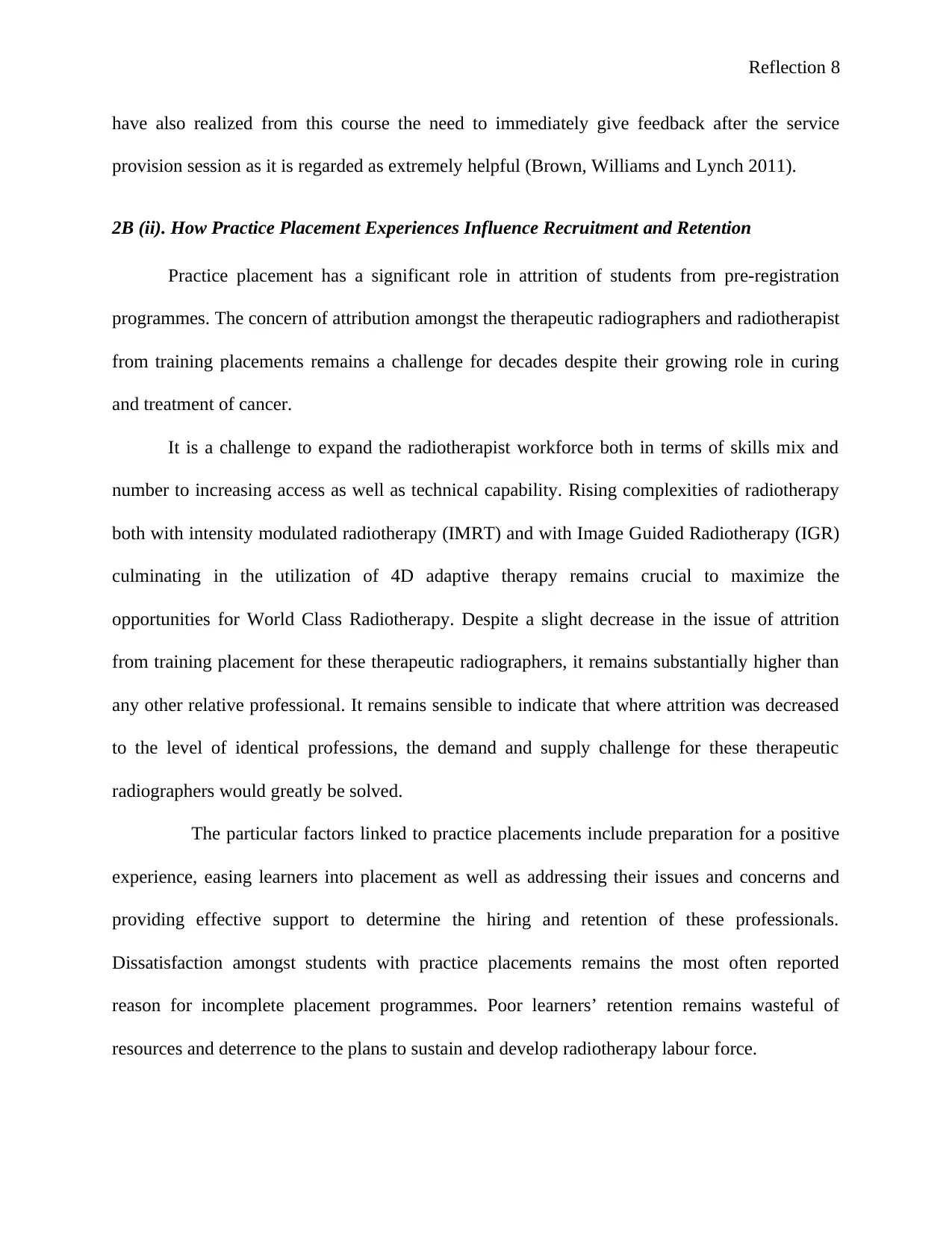
Reflection 8
have also realized from this course the need to immediately give feedback after the service
provision session as it is regarded as extremely helpful (Brown, Williams and Lynch 2011).
2B (ii). How Practice Placement Experiences Influence Recruitment and Retention
Practice placement has a significant role in attrition of students from pre-registration
programmes. The concern of attribution amongst the therapeutic radiographers and radiotherapist
from training placements remains a challenge for decades despite their growing role in curing
and treatment of cancer.
It is a challenge to expand the radiotherapist workforce both in terms of skills mix and
number to increasing access as well as technical capability. Rising complexities of radiotherapy
both with intensity modulated radiotherapy (IMRT) and with Image Guided Radiotherapy (IGR)
culminating in the utilization of 4D adaptive therapy remains crucial to maximize the
opportunities for World Class Radiotherapy. Despite a slight decrease in the issue of attrition
from training placement for these therapeutic radiographers, it remains substantially higher than
any other relative professional. It remains sensible to indicate that where attrition was decreased
to the level of identical professions, the demand and supply challenge for these therapeutic
radiographers would greatly be solved.
The particular factors linked to practice placements include preparation for a positive
experience, easing learners into placement as well as addressing their issues and concerns and
providing effective support to determine the hiring and retention of these professionals.
Dissatisfaction amongst students with practice placements remains the most often reported
reason for incomplete placement programmes. Poor learners’ retention remains wasteful of
resources and deterrence to the plans to sustain and develop radiotherapy labour force.
have also realized from this course the need to immediately give feedback after the service
provision session as it is regarded as extremely helpful (Brown, Williams and Lynch 2011).
2B (ii). How Practice Placement Experiences Influence Recruitment and Retention
Practice placement has a significant role in attrition of students from pre-registration
programmes. The concern of attribution amongst the therapeutic radiographers and radiotherapist
from training placements remains a challenge for decades despite their growing role in curing
and treatment of cancer.
It is a challenge to expand the radiotherapist workforce both in terms of skills mix and
number to increasing access as well as technical capability. Rising complexities of radiotherapy
both with intensity modulated radiotherapy (IMRT) and with Image Guided Radiotherapy (IGR)
culminating in the utilization of 4D adaptive therapy remains crucial to maximize the
opportunities for World Class Radiotherapy. Despite a slight decrease in the issue of attrition
from training placement for these therapeutic radiographers, it remains substantially higher than
any other relative professional. It remains sensible to indicate that where attrition was decreased
to the level of identical professions, the demand and supply challenge for these therapeutic
radiographers would greatly be solved.
The particular factors linked to practice placements include preparation for a positive
experience, easing learners into placement as well as addressing their issues and concerns and
providing effective support to determine the hiring and retention of these professionals.
Dissatisfaction amongst students with practice placements remains the most often reported
reason for incomplete placement programmes. Poor learners’ retention remains wasteful of
resources and deterrence to the plans to sustain and develop radiotherapy labour force.
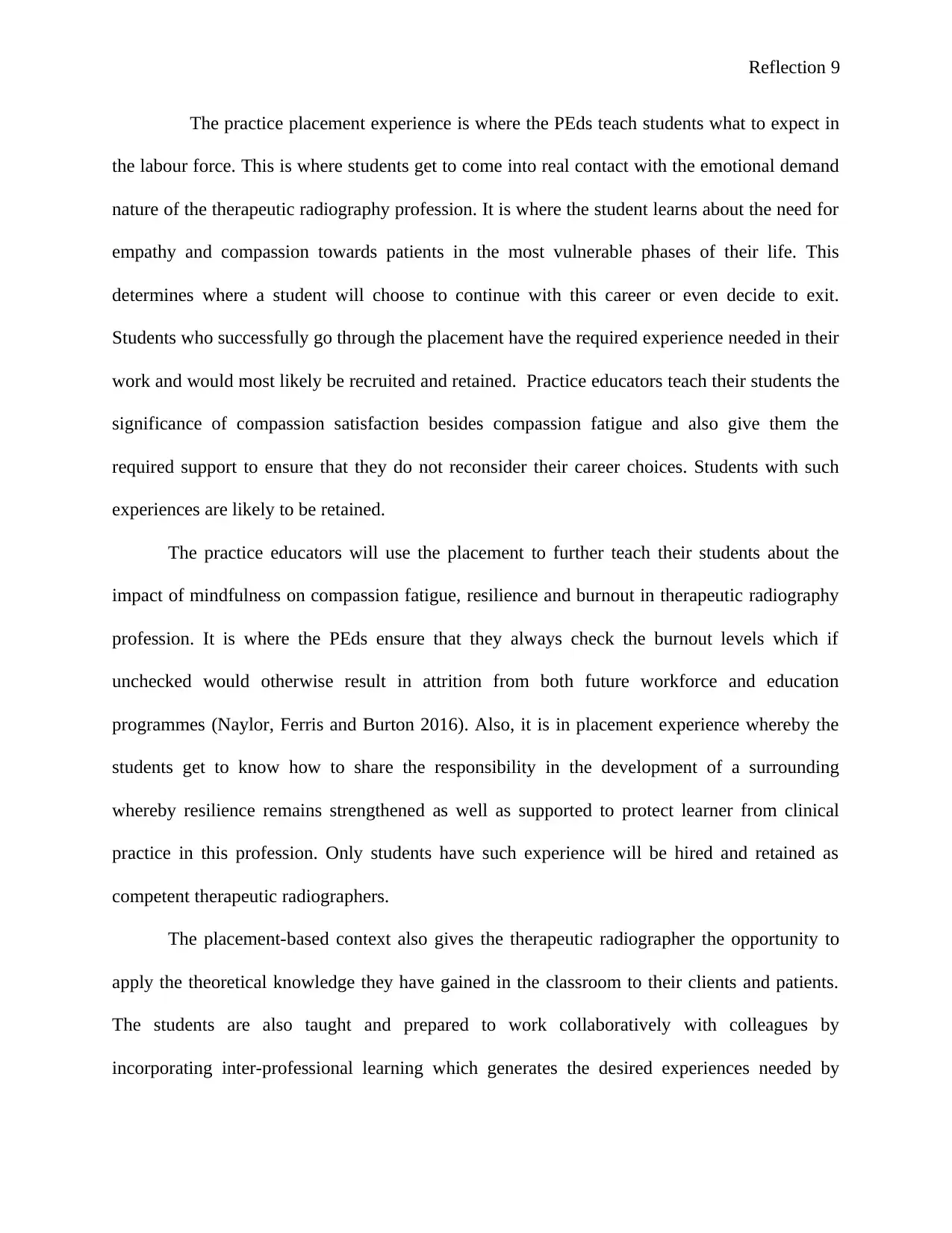
Reflection 9
The practice placement experience is where the PEds teach students what to expect in
the labour force. This is where students get to come into real contact with the emotional demand
nature of the therapeutic radiography profession. It is where the student learns about the need for
empathy and compassion towards patients in the most vulnerable phases of their life. This
determines where a student will choose to continue with this career or even decide to exit.
Students who successfully go through the placement have the required experience needed in their
work and would most likely be recruited and retained. Practice educators teach their students the
significance of compassion satisfaction besides compassion fatigue and also give them the
required support to ensure that they do not reconsider their career choices. Students with such
experiences are likely to be retained.
The practice educators will use the placement to further teach their students about the
impact of mindfulness on compassion fatigue, resilience and burnout in therapeutic radiography
profession. It is where the PEds ensure that they always check the burnout levels which if
unchecked would otherwise result in attrition from both future workforce and education
programmes (Naylor, Ferris and Burton 2016). Also, it is in placement experience whereby the
students get to know how to share the responsibility in the development of a surrounding
whereby resilience remains strengthened as well as supported to protect learner from clinical
practice in this profession. Only students have such experience will be hired and retained as
competent therapeutic radiographers.
The placement-based context also gives the therapeutic radiographer the opportunity to
apply the theoretical knowledge they have gained in the classroom to their clients and patients.
The students are also taught and prepared to work collaboratively with colleagues by
incorporating inter-professional learning which generates the desired experiences needed by
The practice placement experience is where the PEds teach students what to expect in
the labour force. This is where students get to come into real contact with the emotional demand
nature of the therapeutic radiography profession. It is where the student learns about the need for
empathy and compassion towards patients in the most vulnerable phases of their life. This
determines where a student will choose to continue with this career or even decide to exit.
Students who successfully go through the placement have the required experience needed in their
work and would most likely be recruited and retained. Practice educators teach their students the
significance of compassion satisfaction besides compassion fatigue and also give them the
required support to ensure that they do not reconsider their career choices. Students with such
experiences are likely to be retained.
The practice educators will use the placement to further teach their students about the
impact of mindfulness on compassion fatigue, resilience and burnout in therapeutic radiography
profession. It is where the PEds ensure that they always check the burnout levels which if
unchecked would otherwise result in attrition from both future workforce and education
programmes (Naylor, Ferris and Burton 2016). Also, it is in placement experience whereby the
students get to know how to share the responsibility in the development of a surrounding
whereby resilience remains strengthened as well as supported to protect learner from clinical
practice in this profession. Only students have such experience will be hired and retained as
competent therapeutic radiographers.
The placement-based context also gives the therapeutic radiographer the opportunity to
apply the theoretical knowledge they have gained in the classroom to their clients and patients.
The students are also taught and prepared to work collaboratively with colleagues by
incorporating inter-professional learning which generates the desired experiences needed by
⊘ This is a preview!⊘
Do you want full access?
Subscribe today to unlock all pages.

Trusted by 1+ million students worldwide
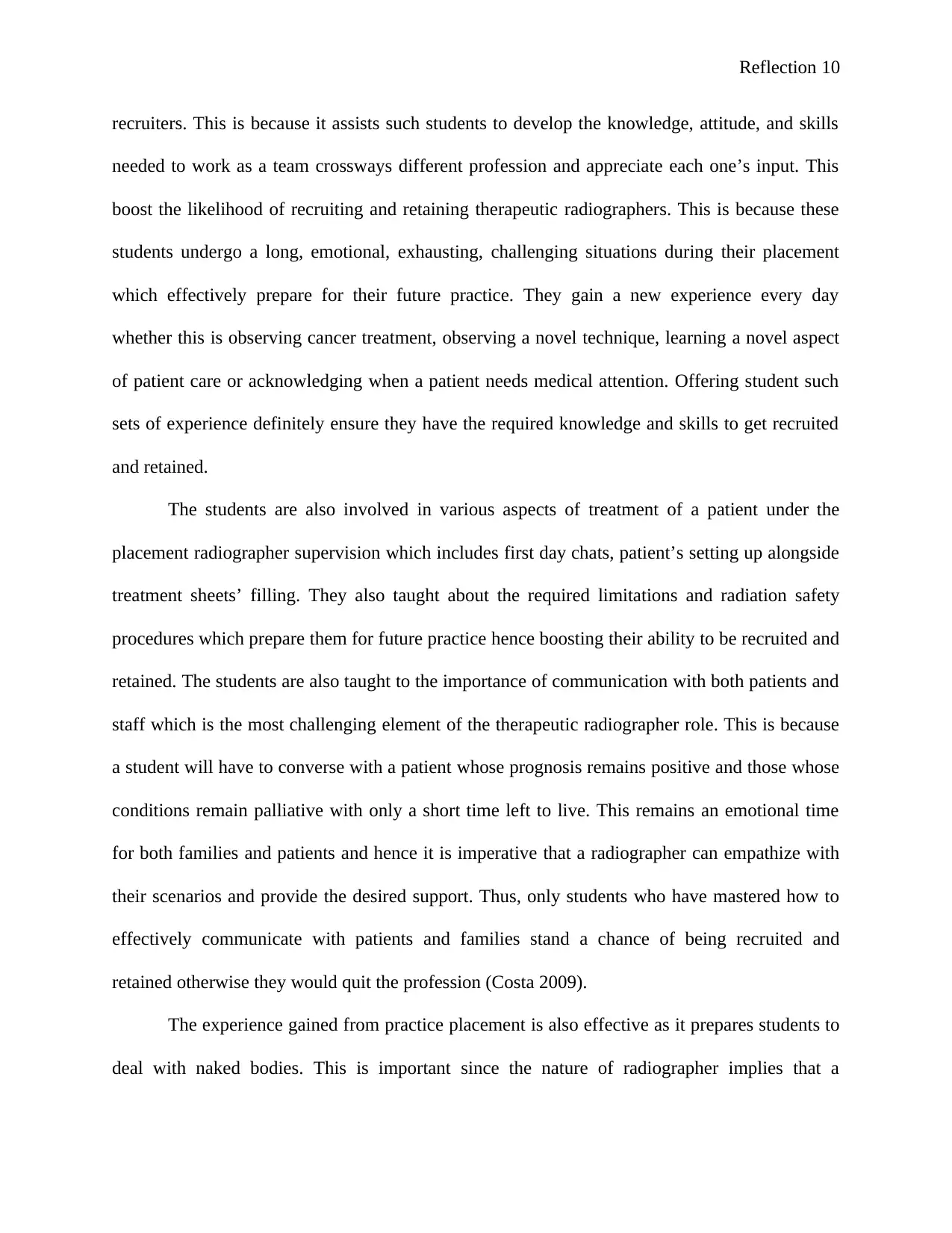
Reflection 10
recruiters. This is because it assists such students to develop the knowledge, attitude, and skills
needed to work as a team crossways different profession and appreciate each one’s input. This
boost the likelihood of recruiting and retaining therapeutic radiographers. This is because these
students undergo a long, emotional, exhausting, challenging situations during their placement
which effectively prepare for their future practice. They gain a new experience every day
whether this is observing cancer treatment, observing a novel technique, learning a novel aspect
of patient care or acknowledging when a patient needs medical attention. Offering student such
sets of experience definitely ensure they have the required knowledge and skills to get recruited
and retained.
The students are also involved in various aspects of treatment of a patient under the
placement radiographer supervision which includes first day chats, patient’s setting up alongside
treatment sheets’ filling. They also taught about the required limitations and radiation safety
procedures which prepare them for future practice hence boosting their ability to be recruited and
retained. The students are also taught to the importance of communication with both patients and
staff which is the most challenging element of the therapeutic radiographer role. This is because
a student will have to converse with a patient whose prognosis remains positive and those whose
conditions remain palliative with only a short time left to live. This remains an emotional time
for both families and patients and hence it is imperative that a radiographer can empathize with
their scenarios and provide the desired support. Thus, only students who have mastered how to
effectively communicate with patients and families stand a chance of being recruited and
retained otherwise they would quit the profession (Costa 2009).
The experience gained from practice placement is also effective as it prepares students to
deal with naked bodies. This is important since the nature of radiographer implies that a
recruiters. This is because it assists such students to develop the knowledge, attitude, and skills
needed to work as a team crossways different profession and appreciate each one’s input. This
boost the likelihood of recruiting and retaining therapeutic radiographers. This is because these
students undergo a long, emotional, exhausting, challenging situations during their placement
which effectively prepare for their future practice. They gain a new experience every day
whether this is observing cancer treatment, observing a novel technique, learning a novel aspect
of patient care or acknowledging when a patient needs medical attention. Offering student such
sets of experience definitely ensure they have the required knowledge and skills to get recruited
and retained.
The students are also involved in various aspects of treatment of a patient under the
placement radiographer supervision which includes first day chats, patient’s setting up alongside
treatment sheets’ filling. They also taught about the required limitations and radiation safety
procedures which prepare them for future practice hence boosting their ability to be recruited and
retained. The students are also taught to the importance of communication with both patients and
staff which is the most challenging element of the therapeutic radiographer role. This is because
a student will have to converse with a patient whose prognosis remains positive and those whose
conditions remain palliative with only a short time left to live. This remains an emotional time
for both families and patients and hence it is imperative that a radiographer can empathize with
their scenarios and provide the desired support. Thus, only students who have mastered how to
effectively communicate with patients and families stand a chance of being recruited and
retained otherwise they would quit the profession (Costa 2009).
The experience gained from practice placement is also effective as it prepares students to
deal with naked bodies. This is important since the nature of radiographer implies that a
Paraphrase This Document
Need a fresh take? Get an instant paraphrase of this document with our AI Paraphraser
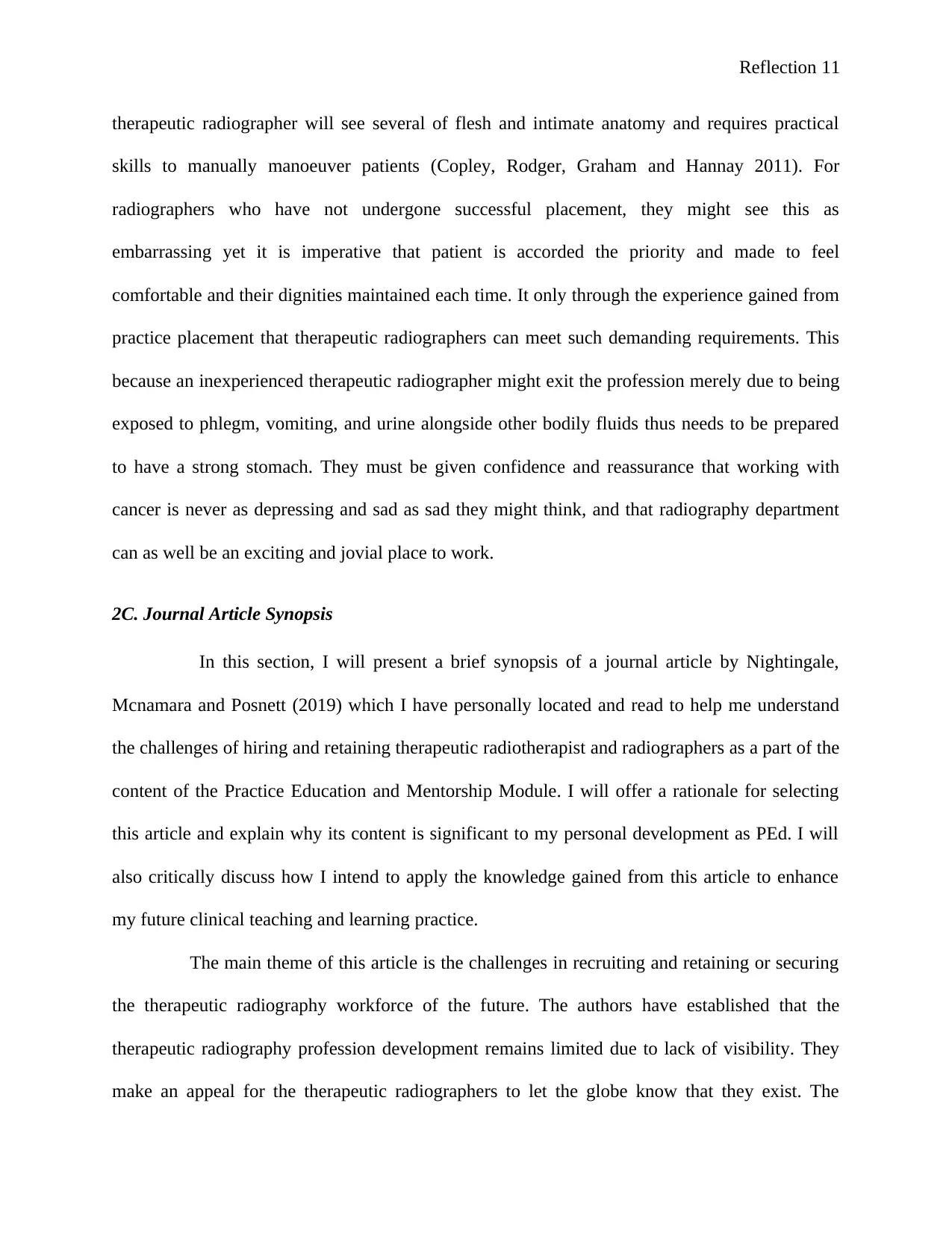
Reflection 11
therapeutic radiographer will see several of flesh and intimate anatomy and requires practical
skills to manually manoeuver patients (Copley, Rodger, Graham and Hannay 2011). For
radiographers who have not undergone successful placement, they might see this as
embarrassing yet it is imperative that patient is accorded the priority and made to feel
comfortable and their dignities maintained each time. It only through the experience gained from
practice placement that therapeutic radiographers can meet such demanding requirements. This
because an inexperienced therapeutic radiographer might exit the profession merely due to being
exposed to phlegm, vomiting, and urine alongside other bodily fluids thus needs to be prepared
to have a strong stomach. They must be given confidence and reassurance that working with
cancer is never as depressing and sad as sad they might think, and that radiography department
can as well be an exciting and jovial place to work.
2C. Journal Article Synopsis
In this section, I will present a brief synopsis of a journal article by Nightingale,
Mcnamara and Posnett (2019) which I have personally located and read to help me understand
the challenges of hiring and retaining therapeutic radiotherapist and radiographers as a part of the
content of the Practice Education and Mentorship Module. I will offer a rationale for selecting
this article and explain why its content is significant to my personal development as PEd. I will
also critically discuss how I intend to apply the knowledge gained from this article to enhance
my future clinical teaching and learning practice.
The main theme of this article is the challenges in recruiting and retaining or securing
the therapeutic radiography workforce of the future. The authors have established that the
therapeutic radiography profession development remains limited due to lack of visibility. They
make an appeal for the therapeutic radiographers to let the globe know that they exist. The
therapeutic radiographer will see several of flesh and intimate anatomy and requires practical
skills to manually manoeuver patients (Copley, Rodger, Graham and Hannay 2011). For
radiographers who have not undergone successful placement, they might see this as
embarrassing yet it is imperative that patient is accorded the priority and made to feel
comfortable and their dignities maintained each time. It only through the experience gained from
practice placement that therapeutic radiographers can meet such demanding requirements. This
because an inexperienced therapeutic radiographer might exit the profession merely due to being
exposed to phlegm, vomiting, and urine alongside other bodily fluids thus needs to be prepared
to have a strong stomach. They must be given confidence and reassurance that working with
cancer is never as depressing and sad as sad they might think, and that radiography department
can as well be an exciting and jovial place to work.
2C. Journal Article Synopsis
In this section, I will present a brief synopsis of a journal article by Nightingale,
Mcnamara and Posnett (2019) which I have personally located and read to help me understand
the challenges of hiring and retaining therapeutic radiotherapist and radiographers as a part of the
content of the Practice Education and Mentorship Module. I will offer a rationale for selecting
this article and explain why its content is significant to my personal development as PEd. I will
also critically discuss how I intend to apply the knowledge gained from this article to enhance
my future clinical teaching and learning practice.
The main theme of this article is the challenges in recruiting and retaining or securing
the therapeutic radiography workforce of the future. The authors have established that the
therapeutic radiography profession development remains limited due to lack of visibility. They
make an appeal for the therapeutic radiographers to let the globe know that they exist. The
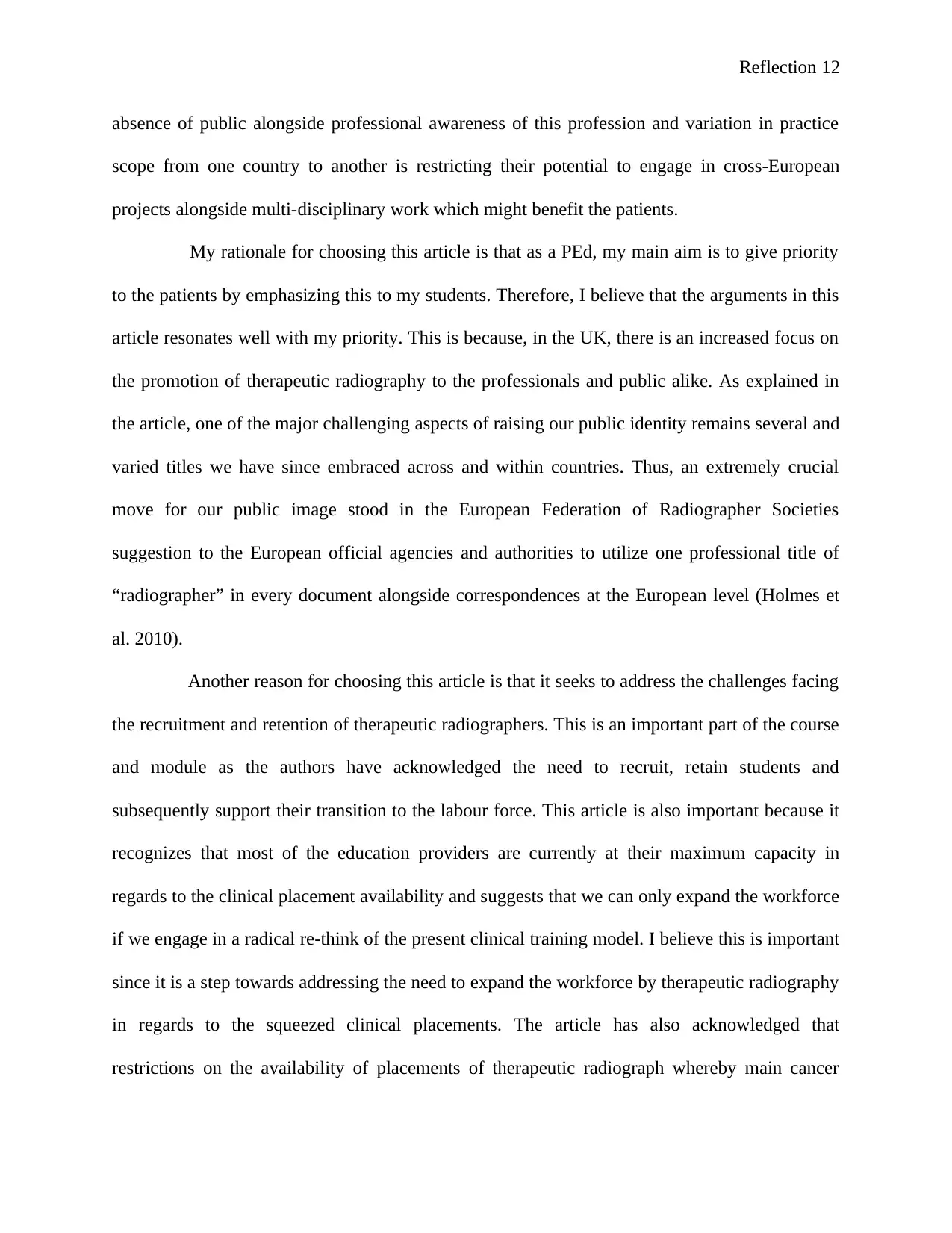
Reflection 12
absence of public alongside professional awareness of this profession and variation in practice
scope from one country to another is restricting their potential to engage in cross-European
projects alongside multi-disciplinary work which might benefit the patients.
My rationale for choosing this article is that as a PEd, my main aim is to give priority
to the patients by emphasizing this to my students. Therefore, I believe that the arguments in this
article resonates well with my priority. This is because, in the UK, there is an increased focus on
the promotion of therapeutic radiography to the professionals and public alike. As explained in
the article, one of the major challenging aspects of raising our public identity remains several and
varied titles we have since embraced across and within countries. Thus, an extremely crucial
move for our public image stood in the European Federation of Radiographer Societies
suggestion to the European official agencies and authorities to utilize one professional title of
“radiographer” in every document alongside correspondences at the European level (Holmes et
al. 2010).
Another reason for choosing this article is that it seeks to address the challenges facing
the recruitment and retention of therapeutic radiographers. This is an important part of the course
and module as the authors have acknowledged the need to recruit, retain students and
subsequently support their transition to the labour force. This article is also important because it
recognizes that most of the education providers are currently at their maximum capacity in
regards to the clinical placement availability and suggests that we can only expand the workforce
if we engage in a radical re-think of the present clinical training model. I believe this is important
since it is a step towards addressing the need to expand the workforce by therapeutic radiography
in regards to the squeezed clinical placements. The article has also acknowledged that
restrictions on the availability of placements of therapeutic radiograph whereby main cancer
absence of public alongside professional awareness of this profession and variation in practice
scope from one country to another is restricting their potential to engage in cross-European
projects alongside multi-disciplinary work which might benefit the patients.
My rationale for choosing this article is that as a PEd, my main aim is to give priority
to the patients by emphasizing this to my students. Therefore, I believe that the arguments in this
article resonates well with my priority. This is because, in the UK, there is an increased focus on
the promotion of therapeutic radiography to the professionals and public alike. As explained in
the article, one of the major challenging aspects of raising our public identity remains several and
varied titles we have since embraced across and within countries. Thus, an extremely crucial
move for our public image stood in the European Federation of Radiographer Societies
suggestion to the European official agencies and authorities to utilize one professional title of
“radiographer” in every document alongside correspondences at the European level (Holmes et
al. 2010).
Another reason for choosing this article is that it seeks to address the challenges facing
the recruitment and retention of therapeutic radiographers. This is an important part of the course
and module as the authors have acknowledged the need to recruit, retain students and
subsequently support their transition to the labour force. This article is also important because it
recognizes that most of the education providers are currently at their maximum capacity in
regards to the clinical placement availability and suggests that we can only expand the workforce
if we engage in a radical re-think of the present clinical training model. I believe this is important
since it is a step towards addressing the need to expand the workforce by therapeutic radiography
in regards to the squeezed clinical placements. The article has also acknowledged that
restrictions on the availability of placements of therapeutic radiograph whereby main cancer
⊘ This is a preview!⊘
Do you want full access?
Subscribe today to unlock all pages.

Trusted by 1+ million students worldwide
1 out of 16
Related Documents
Your All-in-One AI-Powered Toolkit for Academic Success.
+13062052269
info@desklib.com
Available 24*7 on WhatsApp / Email
![[object Object]](/_next/static/media/star-bottom.7253800d.svg)
Unlock your academic potential
Copyright © 2020–2025 A2Z Services. All Rights Reserved. Developed and managed by ZUCOL.





